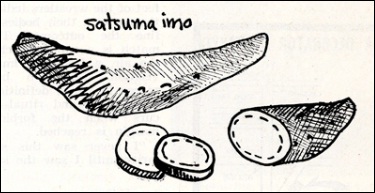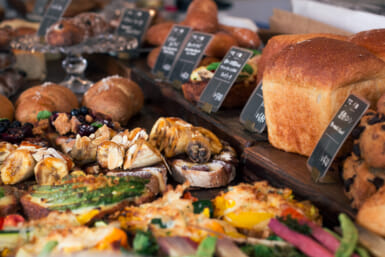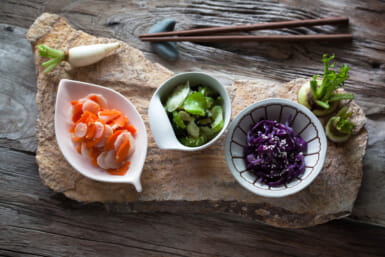with Elizabeth Andoh
New Year’s anywhere in the world is an exciting festival time. In Japan its a paradox of hectic activity and peaceful days.
There are so many special New Years foods, called osechi ryori, that I had a hard time deciding just which I should present. I overrode strict tradition and opted instead for the practical-in-the-sense-that-they-could- fit-a-western-meal-too approach.
The following recipes are quite authentic, but they will taste equally as good as garnishes or side dishes to baked ham or roast turkey as they do in a Japanese meal. Both recipes can be prepared several days in advance (and will keep well if there are any left-overs) which makes them good holiday dishes.
* * *
KOHAKU NAMASU (“red and white” salad)
ingredients:
- 1/4 carrot
- 5-6 inches daikon
- 1-2 tablespoons salt
- 1-2 dried persimmons (or apricots)
- 1/4 peel of yuzu (or 1/8 peel of a lemon)
- amazu sauce (Suki-Yacking, Aug. 9, 1974, given in the subasu recipe)
instructions:
1. Peel the daikon and cut into very fine match stick like slivers. (This will yield about 3/4 cup or more.)
2. In a small bowl, sprinkle some of the salt over the cut daikon and squeeze out excess moisture.
3. Peel the carrot and cut it like the daikon. (This should yield almost 1/4 to 1/3 cup.)
4. In a small bowl, sprinkle some of the salt over the cut carrot and squeeze out excess moisture. Combine the squeezed, drained (rather limp) vegetables.
5. Thinly slice dried persimmon or apricot, trying to make the slices as similar in size as possible to the vegetables. Add it to the daikon and carrot, and toss.
6. Peel about 1/4 of a yuzu (or less of lemon), carefully removing as much pith as possible. Slice in long thin slivers and add these to the other cut vegetables and fruit.
7. Marinate all in 1/4 to 1/2 cups amazu for at least 1 hour (if at room temperature) and up to 2 days (if refrigerated). Remove the vegetables and fruits from the amazu before serving. Serve chilled, or at room temperature. Serve in scooped out lemon or yuzu shells for extra elegance and aroma.
notes:
1. Daikon is often referred to as “icicle” or “white” radish in English. This highly versatile vegetable is a staple in the Japanese diet. Winter daikon are usually large, but pieces should be available in any market.
2. Dried persimmons (ka-ki or hoshi-gaki) are nutritious and delicious. Be sure to remove pits before slicing.
3. Yuzu is a wonderfully fragrant fruit of the citron family. Only its peel is eaten; the inner fruit is very bitter.
4. Kohaku namasu if drained of excess marinade and covered and refrigerated, will keep for 4-5 days.
* * *
KURI KINTON (Sweet chestnuts in yam paste)
ingredients:
- 1 jar (420 gr.) of sweet chestnuts in heavy syrup
- 2 large satsumaimo (about 600 gr.)
- 1-2 tablespoons (yaku-myoban) in
- 2 cups of water
- 1 1/3 cups of sugar
- 3-4 tablespoons syrup from chestnuts
- 2 tablespoons (mirin)
instructions:
1. Peel satsumaimo (use the “line” near the skin as a guideline) and slice in 1/2-inch thick rounds.
2. Parboil the satsumaimo in the yakimyoban water until yellowish.
3. Drain the satsumaimo and rinse them thoroughouly in cold water. Rinse out the pot, too, and fill it with fresh cold water to barely cover the satsumaimo. Bring the water to a boil.
4. Cut kuchinashi-no-mi in half, on the diagonal. Put them to the boiling water. (A deep saffron-yellow color will be released.)
5. Continue boiling the satsumaimo until they are soft (test with a toothpick or chopstick). Remove the pot from the heat and let it stand a few minutes.
6. Carefully drain the satsumaimo and put them through a fine sieve and mash them (the Japanese have a special “appliance” called an uragoshi—details on this in the notes section).
7. Transfer the sieved, mashed satsumaimo to a heavy saucepan and add the sugar. Mix thoroughly over low heat.
8. Add the chestnut syrup. Continue stirring for several minutes.
9. Add drained chestnuts (cut large ones in half or quarters) and heat through. Add mirin, stir, and remove from heat.
10. Allow the mixture to cool slightly before turning out. The mixture will stiffen as it cools. Covered and refrigerated, kuri kinton keeps for months.
notes:
1. Sweet chestnuts are called ama-guri, but the ones in syrup (in glass jars) are called kuro no kanroni.
2. Satsumaimo are sweet potatoes or yams. They have purplish skins and yellow flesh. 600 grams (unpeeled) will yield about 1 2/3 to 1 3/4 cups well-packed “mashed” potatoes.
3. Yakimyoban, sold at yakkyoku-ya or kusuri-ya (drugstores) is a kind of white alum powder. It is used here to preserve color, though it doesn’t affect the taste. A small bag costs about ¥100.
4. Kuchinashi-no-mi are dried gardenia seeds. These, too, are sold at yakkyoku-ya or kusuri-ya. 2 or 3 in a small plastic back cost about ¥150 to ¥200. The kuchina-shi-no-mi are added to intensify color; artificial food coloring could be substituted.
5. An uragoshi is a fine net-mesh stretched over a round, wooden frame. Foods are placed on top and forced through the mesh by pressing with a flat wooden spoon (shamoji). Good uragoshi are made of horse-hair (not nylon) and should be dampened with water before each use, (Flick away excess water with a clean cloth). Uragoshi are not cheap (average size cost about ¥2,000), but they are a delight to own—especially if you are a fan of regular mashed potatoes or other semi-pureed vegetables. Don’t forget to put a bowl underneath to catch the mashed food!










